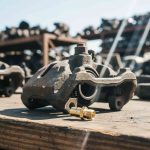Understanding Your Vehicle’s Water Pump and Its Critical Role
A water pump is one of the most crucial components in your vehicle’s cooling system, responsible for maintaining optimal engine temperature by circulating coolant throughout the engine block, cylinder head, and radiator. Without a properly functioning water pump, your engine faces the risk of severe overheating damage that can cost thousands of dollars to repair.
The water pump’s operation relies on an impeller that creates centrifugal force to push coolant through the engine’s cooling passages. This continuous circulation process keeps your engine operating at the ideal temperature of around 200°F (90°C), preventing costly overheating issues.
Recognizing the Warning Signs of Water Pump Failure
Identifying water pump problems early can save you from expensive engine repairs. Understanding these warning signs is essential for every vehicle owner.
| Warning Sign | Description | Action Required |
|---|---|---|
| Coolant Leaks | Bright-colored puddles under the front of your vehicle | Immediate inspection needed |
| Engine Overheating | Temperature gauge rising into red zone | Stop driving immediately |
| Whining/Grinding Noise | Unusual sounds from the pump area | Schedule repair soon |
| Steam from Hood | Visible steam indicating overheating | Pull over safely |
| Corroded Pulley | Rust or corrosion on water pump pulley | Professional inspection |
When you notice any of these symptoms, it’s crucial to address the issue promptly. Understanding your cooling system can help you make informed decisions about repairs and replacements.
Why Salvage Yards Are Smart Sources for Used Water Pumps
When facing water pump replacement, many vehicle owners automatically think of purchasing new parts. However, buying recycled auto parts from salvage yards offers numerous advantages that make it an intelligent choice for budget-conscious car owners.
- Significant Cost Savings: Used water pumps typically cost 50-80% less than new OEM parts
- Environmental Benefits: Reduces waste and supports sustainable automotive practices
- OEM Quality: Original equipment manufacturer parts that maintain factory specifications
- Immediate Availability: Large inventory of parts for various makes and models
- Tested Components: Many salvage yards test parts before selling
- Warranty Options: Some yards offer limited warranties on critical components
The growing market for used auto parts demonstrates increasing consumer confidence in salvaged components. This trend reflects both economic necessity and environmental consciousness among modern vehicle owners.
How to Find Quality Used Water Pumps at Salvage Yards
Successfully purchasing a used water pump requires careful inspection and informed decision-making. Knowing when to buy used auto parts can help you make the right choice for your specific situation.
Pre-Purchase Research and Preparation
- Vehicle Compatibility: Know your exact year, make, model, and engine size
- Part Numbers: Obtain OEM part numbers for precise matching
- Salvage Yard Research: Read reviews and check auto recycler reputation
- Price Comparison: Compare costs across multiple salvage yards
- Warranty Policies: Understand return and warranty options
Physical Inspection Checklist
| Component | What to Check | Red Flags |
|---|---|---|
| Pump Housing | Cracks, corrosion, physical damage | Visible cracks or severe corrosion |
| Impeller | Wear, erosion, blade damage | Pitted, broken, or missing blades |
| Bearing | Smooth rotation, no play or grinding | Wobbling, resistance, or grinding noise |
| Seals | Coolant residue, leakage signs | Visible coolant stains or active leaks |
| Mounting Surface | Smooth, undamaged surface | Warped or damaged mounting points |
“When sourcing used parts, especially critical ones like a water pump, due diligence is paramount. A visual inspection and checking for bearing play are non-negotiable steps. If you’re unsure, it’s always better to err on the side of caution and seek a professional opinion.”
Step-by-Step Water Pump Removal Process
Replacing a water pump requires careful attention to detail and proper tools. Before beginning, ensure you have experience with automotive repairs or consult a certified mechanic if you’re unsure about any step.
Required Tools and Materials
- Basic Tools: Socket set, wrenches, pliers, screwdrivers
- Safety Equipment: Safety glasses, gloves, jack and jack stands
- Fluids: Appropriate coolant type for your vehicle
- Replacement Parts: New gaskets, seals, and clamps as needed
- Cleaning Supplies: Gasket scraper, cleaning solvent, rags
Having the right tools for junkyard visits ensures you can properly inspect and remove parts when needed.
Safety Preparations
- Engine Temperature: Allow engine to cool completely (minimum 2 hours)
- Battery Disconnection: Remove negative battery terminal
- Workspace Preparation: Ensure adequate lighting and ventilation
- Coolant Disposal: Prepare proper disposal containers for old coolant
Removal Procedure
- Step 1: Drain cooling system completely using radiator drain plug
- Step 2: Remove engine accessories blocking access (fan, shroud, belts)
- Step 3: Disconnect radiator and heater hoses from water pump
- Step 4: Remove water pump pulley (may require special holding tool)
- Step 5: Unbolt water pump from engine block in cross pattern
- Step 6: Carefully remove old pump and clean mounting surface thoroughly
Understanding how water pumps work in vehicles helps during the removal process, as you’ll better understand the component connections and their importance.
Installing Your Used Water Pump
Proper installation of your salvaged water pump is crucial for long-term reliability. Following manufacturer specifications and best practices ensures optimal performance and prevents premature failure.
Installation Best Practices
| Installation Step | Key Points | Common Mistakes to Avoid |
|---|---|---|
| Surface Preparation | Clean, smooth mounting surface | Leaving old gasket material |
| Gasket Installation | Proper sealant application | Using wrong sealant type |
| Bolt Torque | Follow manufacturer specifications | Over-tightening bolts |
| Hose Connections | Secure all clamps properly | Loose or misaligned hoses |
| Belt Tension | Proper belt alignment and tension | Incorrect belt routing |
Post-Installation Procedures
- Coolant Refill: Use manufacturer-specified coolant mixture
- Air Bleeding: Properly bleed air from cooling system
- Initial Testing: Run engine and monitor for leaks
- Temperature Monitoring: Watch temperature gauge during test drive
- Final Inspection: Check all connections after initial operation
Many installation issues stem from common car maintenance and repair mistakes. Taking time to follow proper procedures prevents these costly errors.
Cost Comparison: New vs. Used Water Pumps
Understanding the financial implications of your water pump replacement decision helps justify the salvage yard approach. The cost savings can be substantial, especially for older vehicles where the repair cost approaches the vehicle’s value.
| Vehicle Type | New OEM Pump | Used Pump | Potential Savings |
|---|---|---|---|
| Domestic Compact Car | $150-$300 | $30-$75 | $75-$225 |
| Import Mid-Size | $200-$450 | $45-$120 | $155-$330 |
| Luxury Vehicle | $400-$800 | $80-$200 | $320-$600 |
| Truck/SUV | $250-$500 | $50-$150 | $200-$350 |
These savings become even more significant when you consider that OEM parts from junkyards maintain the same quality standards as new parts while offering substantial cost advantages.
Maximizing Your Salvage Yard Experience
Getting the best value from your salvage yard visit requires strategic planning and knowledge of how these operations work. Smart people save money by understanding salvage yard operations and timing their visits strategically.
Optimal Timing for Salvage Yard Visits
- Weekday Visits: Less crowded, better part availability
- New Inventory Days: Fresh vehicles with untouched parts
- Seasonal Considerations: Best days to visit salvage yards for optimal selection
- Weather Factors: Avoid extreme weather for safety and comfort
- Special Sales: Take advantage of promotional pricing periods
Building Relationships with Salvage Yard Staff
Developing good relationships with salvage yard employees can provide significant advantages. Knowledgeable staff can alert you to new arrivals, help locate specific parts, and provide valuable advice about part condition and compatibility.
- Professional Interaction: Treat staff with respect and professionalism
- Regular Communication: Stay in touch about needed parts
- Feedback Provision: Share your experiences with purchased parts
- Referral Network: Connect with other customers for part exchanges
Preventive Maintenance to Extend Water Pump Life
Whether you install a new or used water pump, proper maintenance significantly extends its operational life. Understanding comprehensive car maintenance helps prevent premature water pump failure and protects your investment.
Essential Cooling System Maintenance
| Maintenance Task | Frequency | Impact on Water Pump |
|---|---|---|
| Coolant Flush | Every 30,000-50,000 miles | Prevents corrosion and deposits |
| Thermostat Inspection | Every 60,000 miles | Maintains proper temperature regulation |
| Belt Replacement | Every 60,000-100,000 miles | Prevents pump bearing stress |
| Hose Inspection | Every 20,000 miles | Prevents system pressure loss |
| Radiator Cleaning | Annually | Maintains efficient heat transfer |
Regular attention to these maintenance items prevents many water pump problems. When issues do arise, understanding thermostat replacement costs and other cooling system component expenses helps with budget planning.
Environmental Impact and Sustainability
Choosing recycled auto parts contributes significantly to environmental sustainability. The automotive recycling industry prevents millions of tons of waste from entering landfills while reducing the demand for raw materials needed in new part manufacturing.
- Waste Reduction: Prevents usable parts from becoming landfill waste
- Energy Conservation: Reduces energy required for new part manufacturing
- Resource Preservation: Decreases demand for raw materials like steel and aluminum
- Carbon Footprint: Lower transportation and manufacturing emissions
- Economic Benefits: Supports local recycling businesses and jobs
Understanding how auto salvage yards operate provides insight into this important environmental industry and its contribution to sustainable transportation.
Troubleshooting Common Water Pump Issues
Even with careful selection and installation, used water pumps may occasionally develop problems. Understanding common issues and their solutions helps maintain optimal cooling system performance.
Diagnostic Guide for Water Pump Problems
| Symptom | Possible Cause | Solution |
|---|---|---|
| Gradual Coolant Loss | Seal wear, gasket failure | Replace seals or pump |
| Intermittent Overheating | Partial impeller damage | Water pump replacement |
| Bearing Noise | Worn pump bearings | Complete pump replacement |
| Belt Squeal | Misaligned or damaged pulley | Pulley adjustment or replacement |
| Rapid Coolant Loss | Catastrophic pump failure | Immediate pump replacement |
When experiencing overheating issues, it’s important to understand various causes. Car overheating when AC is on can indicate multiple cooling system problems that may affect water pump performance.
Building Your Automotive Repair Skills
Successfully replacing a water pump with a salvage yard part builds confidence for future repairs. This experience opens doors to other cost-saving automotive maintenance opportunities that can significantly reduce vehicle ownership costs.
Progressive Skill Development
- Basic Repairs: Start with simple components like used car starters
- Intermediate Projects: Progress to more complex systems and components
- Advanced Repairs: Tackle major components like used transmissions
- Specialty Systems: Learn about emerging technologies and electric vehicle components
Understanding common car problems helps prioritize which repair skills to develop first, focusing on issues most likely to affect your specific vehicle.
Conclusion: Smart Water Pump Replacement Strategy
Successfully finding and replacing a used water pump from a salvage yard represents smart automotive ownership. This approach combines significant cost savings with environmental responsibility while maintaining vehicle reliability and performance.
The key to success lies in careful part selection, thorough inspection, and proper installation techniques. By following the comprehensive guidance outlined in this article, you can confidently navigate the salvage yard environment and complete a professional-quality water pump replacement.
Remember that every successful repair builds your automotive knowledge and capabilities. Whether you’re dealing with cooling system issues, exploring high-value used parts, or planning future maintenance, the skills and knowledge gained from this water pump replacement project will serve you well in all your automotive endeavors.
Take advantage of the resources available at quality salvage yards to maintain your vehicle affordably while contributing to sustainable automotive practices. Your wallet and the environment will thank you for this smart approach to automotive maintenance and repair.





Leave a Reply
You must be logged in to post a comment.